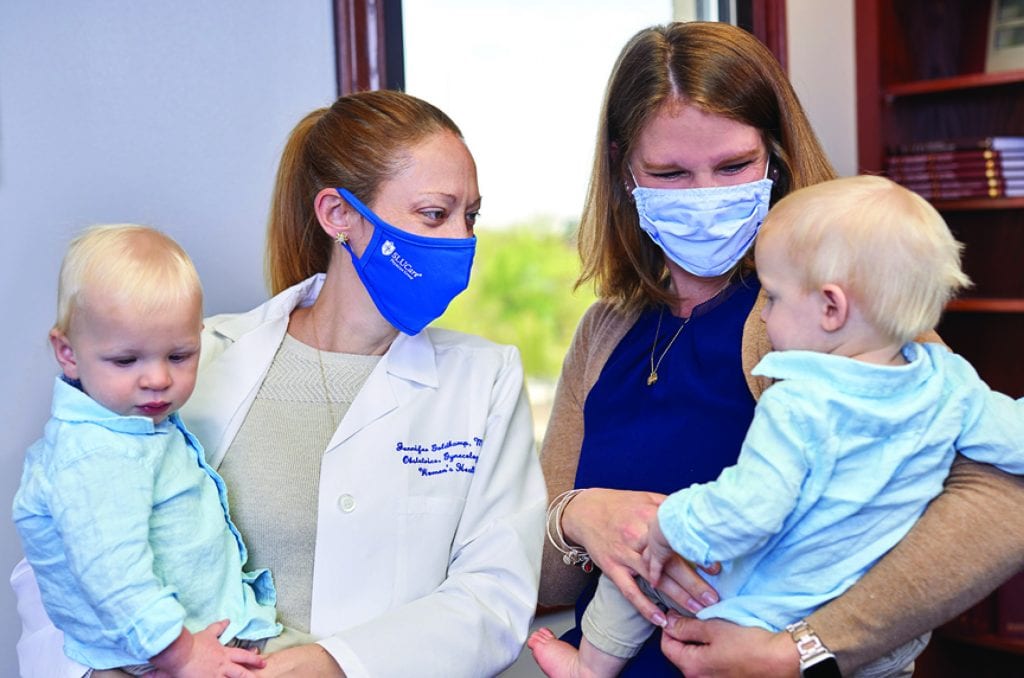Years ago, it was assumed that once a woman gave birth by cesarean section, all of her later deliveries would have to be by the same method. However, SLUCare obstetrician and gynecologist Dr. Jen Goldkamp says the thinking on this subject has changed significantly in recent years.
“The phrase commonly used in the past was, ‘Once a C-section, always a C-section,’ but that’s no longer thought to be accurate,” she explains. “We have good data showing that vaginal birth can happen safely after a C-section in many cases. SLUCare practitioners are glad to be able to support women who want to return to natural childbirth.”
Patient Lauren Bootz says that ability to choose was a key part of her positive birth experience at SSM Health St. Mary’s Hospital last year. She had undergone a C-section in the past but wanted to deliver naturally when she went into labor with twins a year ago. She met with Goldkamp to discuss options, and it was decided that a vaginal birth would be possible in her case.
Bootz says the SLUCare staff listened to her preferences and cared about giving her the kind of birth experience she wanted. “I can’t say enough good things about them,” she says. “Of course, they followed all of the proper protocols, but whenever there was a situation where I could make a choice, they supported me. Even if there was a chance the answer would be no, they always listened and checked on things when I asked.”
She says her twins were unusually large and moved quite a bit just before birth, so the delivery required careful monitoring. “I wanted to be able to get up, walk around and do other things to stay occupied during labor, and the nurses accommodated me as much as possible,” she says. “One of the best things about Dr. Goldkamp and the staff is how much they listen and care. My birth process was not just about being told what would happen; it was about being heard and allowed to decide about options and outcomes. The staff answered all of my questions carefully, and Dr. Goldkamp checked on me often before and after the birth process to make sure I was doing well. It was such a relief to be a part of the conversation about my own care.”
Bootz says the SLUCare team’s expertise gave her confidence when it was time to deliver her twins. At one point, when her cervical dilation was progressing slower than expected, the doctor performed a manual manipulation of the first twin to better position him for birth. “After that, the dilation process moved right along,” Bootz says. “I was really impressed with Dr. Goldkamp’s knowledge and experience. She knew exactly how to help me and my babies.”
Goldkamp says the goal is to do what is best for mothers and infants during labor and delivery, and that sometimes means deviating from the original birth plan. That’s another area in which the team’s expertise and flexibility come in. “Having a good birth experience doesn’t always equate to following a birth plan,” Goldkamp says. “If a patient has a strict plan and then is unable to follow it, it’s not a failure of the patient or the system. In any case, the end goal is always a healthy mom and baby.”
She says VBAC (vaginal birth after cesarean) patients are actually less likely to experience birth-related issues like uterine rupture, blood transfusion and unplanned hysterectomy than those who have repeated cesareans. “It’s important to remember that even if you have a high-risk problem, it doesn’t mean you can’t have a good birth experience,” she adds. “Throughout their prenatal care, patients should advocate for themselves and talk with the doctor about how they would like labor and delivery to look. We start that conversation in the doctor’s office and review all of the patient’s desires and expectations. We talk about current standards of labor and delivery management and how the mother’s needs fit into that.”
Goldkamp says uterine rupture is the most common concern in a VBAC birth due to thinning of scar tissue from the cesarean, but the risk is actually very low. “It happens in less than 1% of cases,” she says. “A vaginal birth also tends to require less follow-up care than a cesarean.” Either way, the SLUCare team pays close attention to patients’ needs with the goal of a smooth recovery.
Another birthing option open to SLUCare patients is using the services of a midwife. “Our midwives can perform both prenatal care and delivery, and they have a special interest in natural childbirth,” Goldkamp says. “They are highly trained in techniques like managing pain, and they can offer a complete, personal birth experience.” Also available for patients’ comfort are tub births, wearable fetal monitors to allow them to walk around, and birthing balls to keep them moving during labor.
If a woman prefers not to have an epidural, intravenous medication or nitrous oxide may be considered to manage pain. Whenever it’s possible to personalize the birth experience to fit the mother’s preferences, SLUCare staff try to accommodate, according to Goldkamp. “Our obstetrics staff is committed to providing whatever a woman needs to have a comfortable delivery,” she says. “Giving birth is something she will always remember, so it should be as close to the experience she desires as possible.”
The SLUCare obstetrics team strives to provide personalized care to mothers before, during and after birth. For more information, call 314.977.7455 or search ‘preparing for baby’ at slucare.edu.
Cover design by Julie Streiler
Cover photo courtesy of SLUCare Physician Group
Pictured at top: Dr. Jen Goldkamp with patient Lauren Bootz and twins
Photos courtesy of SLUCare Physician Group
